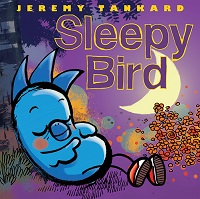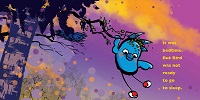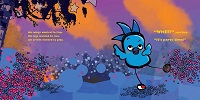| ________________
CM . . . . Volume XXIV Number 22. . . . February 9, 2018

 |
Sleepy Bird.
Jeremy Tankard.
New York, NY: Scholastic (Distributed in Canada by Scholastic Canada), 2018.
28 pp., hardcover, $19.99.
ISBN 978-1-338-15785-7.
Preschool-grade 1 / Ages 3-6.
Review by Dave Jenkinson.
**** /4
|
| |
|

excerpt:
Bird flounced over to Sheep’s place.
“You know what you need?” said Sheep.
“New friends!” suggested Bird.
“You need to count sheep,” said Sheep.
“That always helps me fall asleep.”
“BUT THERE’S ONLY ONE OF YOU”
shouted Bird.
“HOW CAN YOU GET SLEEPY COUNTING TO ONE!!”
Youngsters first met this little blue bird when he was in an ill-humored state in Grumpy Bird. He returned, “injured” and crying, in Boo Hoo Bird and appeared again as a picky eater in Hungry Bird.
 Parents and children will readily identify with the situation Tankard has created in Sleepy Bird as, with bedtime approaching, Bird declares that he “was not ready to go to sleep”. Instead, “It’s party time!” Bird seeks out each of his animal friends, Fox, Beaver, Rabbit, Racoon and Sheep, in turn and invites them to play. They individually respond by pointing out that it’s bedtime, and each offers to share the “something” that assists them in going to sleep: hugging a blankie, reading a story, snuggling a stuffed toy, singing a soft lullaby, and counting sheep. With increasing rudeness, Bird rejects each of his friends’ sleep assistance ideas, even pointing out to Racoon he should not even be considering sleep at this point in the day as racoons are nocturnal creatures. Storming off, Bird decides that, if his friends won’t play with him, “he would just walk forever”. However, his walking is fatiguing, but Bird completely rejects the idea that he might be getting tired, and, in frustration, loudly shouts, “WHY SHOULD I GO TO SLEEP!” Parents and children will readily identify with the situation Tankard has created in Sleepy Bird as, with bedtime approaching, Bird declares that he “was not ready to go to sleep”. Instead, “It’s party time!” Bird seeks out each of his animal friends, Fox, Beaver, Rabbit, Racoon and Sheep, in turn and invites them to play. They individually respond by pointing out that it’s bedtime, and each offers to share the “something” that assists them in going to sleep: hugging a blankie, reading a story, snuggling a stuffed toy, singing a soft lullaby, and counting sheep. With increasing rudeness, Bird rejects each of his friends’ sleep assistance ideas, even pointing out to Racoon he should not even be considering sleep at this point in the day as racoons are nocturnal creatures. Storming off, Bird decides that, if his friends won’t play with him, “he would just walk forever”. However, his walking is fatiguing, but Bird completely rejects the idea that he might be getting tired, and, in frustration, loudly shouts, “WHY SHOULD I GO TO SLEEP!”
 Hearing Bird’s cry, his five friends come running, and simultaneously they apply their “sleep aids” to a still protesting “I...Am...Not...Sleepy...” Bird. Successful in getting Bird to fall asleep, the quintet, themselves, nod off, but Tankard has a final surprise awaiting readers, one with which many parents will ruefully self-identify. Hearing Bird’s cry, his five friends come running, and simultaneously they apply their “sleep aids” to a still protesting “I...Am...Not...Sleepy...” Bird. Successful in getting Bird to fall asleep, the quintet, themselves, nod off, but Tankard has a final surprise awaiting readers, one with which many parents will ruefully self-identify.
The background colours in Tankard’s illustrations mirror the hues of the approaching night as oranges and yellows increasing mix with blues and purples before giving way to the nighttime sky’s dark blues that are somewhat relieved by a rising waxing moon. Tankard engages in a bit of playful “product placement” as the books Beaver offers to read to Bird are the first three books in the series, and the book that Beaver actually shares with Bird during the group’s sleep intervention is Sleepy Bird. Though the text is brief, it is vocabulary rich, and Bird’s facial expressions extend the emotions suggested by the text.
In Bird, Tankard has created an absolutely delightful “child” character, one which, like Paulette Bourgeois and Brenda Clark’s Franklin the Turtle, captures universal aspects of childhood. Sleepy Bird belongs in all libraries.
Highly Recommended.
Dave Jenkinson, CM's editor, lives in Winnipeg, MB.

To comment on this title or this review, send mail to cm@umanitoba.ca.
© CM Association
CC BY-NC-ND
Hosted by the University of Manitoba.
ISSN 1201-9364 |
This Creative Commons license allows you to download the review and share it with others as long as you credit the CM Association. You cannot change the review in any way or use it commercially.
Commercial use is available through a contract with the CM Association. This Creative Commons license allows publishers whose works are being reviewed to download and share said CM reviews provided you credit the CM Association. |
Next Review |
Table of Contents for This Issue
- February 9, 2018.
CM Home
| Back Issues
| Search
| CM Archive
| Profiles Archive
|

 Parents and children will readily identify with the situation Tankard has created in Sleepy Bird as, with bedtime approaching, Bird declares that he “was not ready to go to sleep”. Instead, “It’s party time!” Bird seeks out each of his animal friends, Fox, Beaver, Rabbit, Racoon and Sheep, in turn and invites them to play. They individually respond by pointing out that it’s bedtime, and each offers to share the “something” that assists them in going to sleep: hugging a blankie, reading a story, snuggling a stuffed toy, singing a soft lullaby, and counting sheep. With increasing rudeness, Bird rejects each of his friends’ sleep assistance ideas, even pointing out to Racoon he should not even be considering sleep at this point in the day as racoons are nocturnal creatures. Storming off, Bird decides that, if his friends won’t play with him, “he would just walk forever”. However, his walking is fatiguing, but Bird completely rejects the idea that he might be getting tired, and, in frustration, loudly shouts, “WHY SHOULD I GO TO SLEEP!”
Parents and children will readily identify with the situation Tankard has created in Sleepy Bird as, with bedtime approaching, Bird declares that he “was not ready to go to sleep”. Instead, “It’s party time!” Bird seeks out each of his animal friends, Fox, Beaver, Rabbit, Racoon and Sheep, in turn and invites them to play. They individually respond by pointing out that it’s bedtime, and each offers to share the “something” that assists them in going to sleep: hugging a blankie, reading a story, snuggling a stuffed toy, singing a soft lullaby, and counting sheep. With increasing rudeness, Bird rejects each of his friends’ sleep assistance ideas, even pointing out to Racoon he should not even be considering sleep at this point in the day as racoons are nocturnal creatures. Storming off, Bird decides that, if his friends won’t play with him, “he would just walk forever”. However, his walking is fatiguing, but Bird completely rejects the idea that he might be getting tired, and, in frustration, loudly shouts, “WHY SHOULD I GO TO SLEEP!” Hearing Bird’s cry, his five friends come running, and simultaneously they apply their “sleep aids” to a still protesting “I...Am...Not...Sleepy...” Bird. Successful in getting Bird to fall asleep, the quintet, themselves, nod off, but Tankard has a final surprise awaiting readers, one with which many parents will ruefully self-identify.
Hearing Bird’s cry, his five friends come running, and simultaneously they apply their “sleep aids” to a still protesting “I...Am...Not...Sleepy...” Bird. Successful in getting Bird to fall asleep, the quintet, themselves, nod off, but Tankard has a final surprise awaiting readers, one with which many parents will ruefully self-identify.